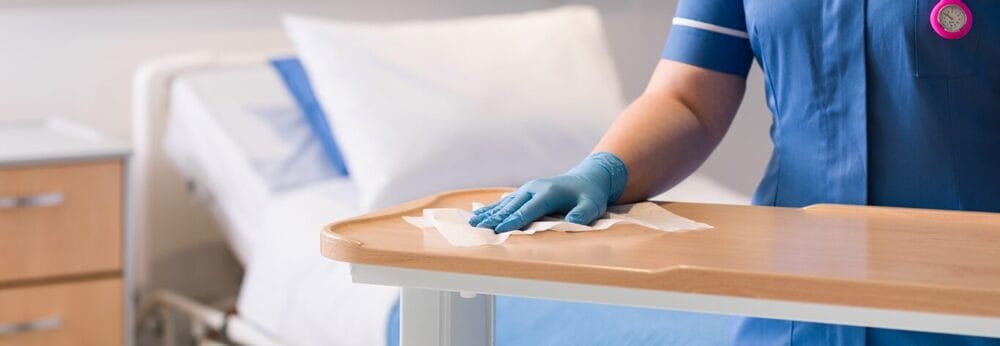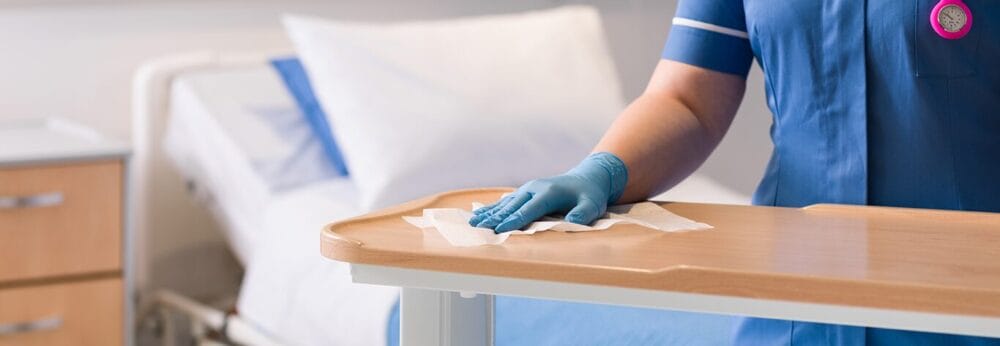Posts Tagged ‘C. DIFF’
Sporicidal disinfection should be the basis of all bundles to prevent C. difficile infection
Since the evidence base is limited, knowledge on what really works to prevent the transmission of pathogens that cause HCAI is limited. This is the case for C. difficile and other hospital pathogens. So, we commonly apply bundles of interventions, in the hope that one or more elements of the bundle will be effective. A recent modelling study helps…
Read MoreUV-C room disinfection reduces viral infection
There is now strong evidence that UV-C room disinfection reduces the transmission of key bacterial pathogens in hospitals, including MRSA, VRE, and perhaps to a lesser degree, C. difficile infection. A new study demonstrates that UV-C room disinfection using GAMA’s Violet UV-C room sanitiser also reduced viral infection. The study was performed is a fairly small 100 bed paediatric…
Read MoreNeutralising duff “sporicidal” claims of amine-based disinfectants
There is a lot of value to a disinfectant manufacturer of having a sporicidal claim so that the product can be used in healthcare settings to tackle C. difficile spores. However, not all products with a sporicidal claim are in fact sporicidal! Amine-based disinfectants with “sporicidal” claims are being seen increasingly in the marketplace, but these products are unlikely…
Read MoreUV light vs. Candida auris
A US study has found that Candida auris exhibited a similar level of susceptibility to UV light as Clostridium difficile spores, and was considerably less susceptible than MRSA. These findings suggest that either extended exposure UV cycles or hydrogen peroxide based room disinfection are required to address environmental contamination with Candida auris. We have posted before on the efficacy of various disinfectants against Candida auris, supporting…
Read MoreWhat healthcare workers should know about environmental contamination
A useful summary of current evidence highlights what healthcare workers should know about environmental contamination in hospitals. Whilst the focus of the article in the ICU, the principles are the same for healthcare workers in other settings too. Bacteria contaminate the inanimate environment; this contributes to patient acquisition of pathogens; biofilms play an important but uncertain role;…
Read MoreIs your wipe really sporicidal?
Sporicidal disinfectant wipes are being used increasingly for tackling surfaces contaminated with C. difficile spores in hospitals. A wide range of ‘sporicidal’ wipes are coming onto the market. However, concerning published data shows that some wipes marketed as being ‘sporicidal’ do not have meaningful activity against spores when tested under controlled laboratory conditions. This blog outlines three key questions…
Read MoreTime to wipe away C. difficile from patients’ hands?
A US study has found that around 15% of patients with C. difficile infection have C. difficile contaminated hands, and that removing these spores from patients’ hands is challenging. The study was performed in a 500-bed US hospital. Around 50 patients with C. difficile infection were enrolled in the study, and randomised to either hand hygiene using either alcohol-based hand rub (ABHR) or…
Read MoreHydrogen peroxide versus bleach; who wins?
A randomised multicentre trial in Italy published this month in the Journal of Hospital Infection has examined the effectiveness of automated hydrogen peroxide (AHP) supplemented with silver ions, and 5,000 ppm sodium hypochlorite (bleach) on Clostridium difficile (CD). Twenty-eight rooms previously occupied by patients with C. difficile infection (CDI) at four health facilities were randomised to either AHP or…
Read MoreWatch out: C. difficile about (and you may not know it)
There has been some recent discussion on whether we should implement screening for asymptomatic carriage of C. difficile. Whilst there is some evidence that cross-transmission of C. difficile from symptomatic cases is rare (in English hospitals, at least), a recent study shows that asymptomatic carriers are an important source of in-hospital transmission of C. difficile. The study was performed over 4 months in a Danish…
Read MoreDismiss hospital floors as a potential source of HCAI pathogens at your peril!
A multicentre US study has shown that hospital floors can be a source of pathogens that can cause HCAI. Floors were heavily contaminated, high-touch items were in frequent contact with floors, and hands became contaminated with hospital pathogens as a result of contact with these items. Anybody who dismissed hospital floors as a potential transmission risk are…
Read More



